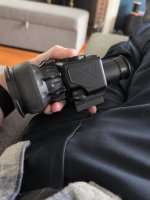It’s been a while since I’ve looked at thermals and within past year or so there are literally a shit ton of options that I’ve never seen or really heard of. I’ve always wanted a nox18 and the XRF.. are these still considered high end? Probably a dumb question as they obviously haven’t just turned to shit all of a sudden, but it seems there is way more talk about all these new budget thermal brands.
Maybe a better question would be are they still worth the $$ with all the options available?
I’m getting tired of buying what I don’t really want and then regretting it. Probably gone through 10+ thermals, last being a new Armasight 640 contractor. It was nice but I never thought image was all that great. In their defense, I sold before I did the firmware upgrade that was supposed to enhance the image
Thanks!
Maybe a better question would be are they still worth the $$ with all the options available?
I’m getting tired of buying what I don’t really want and then regretting it. Probably gone through 10+ thermals, last being a new Armasight 640 contractor. It was nice but I never thought image was all that great. In their defense, I sold before I did the firmware upgrade that was supposed to enhance the image
Thanks!


